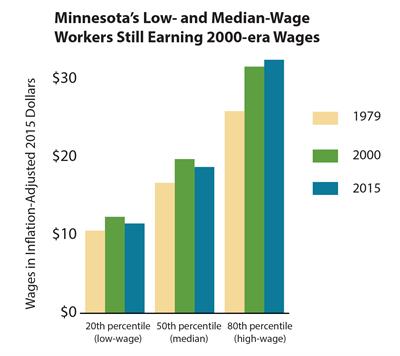Minnesota’s economy has a number of strengths. Incomes are rising, poverty is falling, and unemployment is back to pre-recession levels. Minnesota out-performs our perhaps most comparable neighbor, Wisconsin, in measures including labor force participation and wages.
However, some Minnesotans are not sharing in the state’s success. Minnesota is mirroring the national trend that productivity growth no longer translates into wage growth for most workers, leading to stagnant wages and growing income inequality. Minnesota’s low-wage workers are earning about what they earned 15 years ago, and it’s not enough to make ends meet. We delve into how Minnesota workers are faring in our new report, Minnesota Economy Improving But Harsh Disparities Leave Too Many Workers Behind: The State of Working Minnesota 2016.

Minnesota’s economy has slowly recovered since the Great Recession, but too many workers still struggle to meet their basic needs. Our key findings include:
- Inflation-adjusted wages for low- and middle-wage workers have only just caught up to pre-recession levels, and are closer to inflation-adjusted 2000 wages. This is despite rising productivity, which has increased almost 10 percent since 2007.
- Many Minnesota workers, and in fact over half of Minnesota workers without a college degree, earn less than what it takes to support a family of three. The lack of enough good jobs means juggling the rising costs of child care, transportation, and housing.
- Minnesota’s overall economic success is not reaching all communities: people of color are more likely than other Minnesotans to be unemployed or underemployed. In fact the percentage of African-American workers who can’t find the work they need to support their families is almost three times higher than the percentage for all Minnesota workers.
Minnesota needs a strong workforce to continue building a vibrant economy for years to come. Minnesota can’t afford to leave workers on the sidelines through lack of opportunity. Fortunately policymakers can adopt policies so that more Minnesotans can get and keep quality jobs to support themselves and their families. These include:
- Improving job quality standards, such as expanding paid sick time to more workers;
- Ensuring Minnesotans can get the education and training they need, and can get to good jobs that make full use of their skills; and
- Helping low-wage workers make ends meet and move into the middle class by expanding the Working Family Credit and increasing funding for child care assistance.